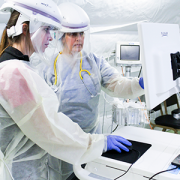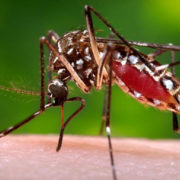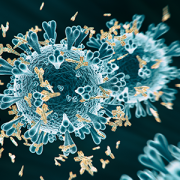Long-term, controlled studies needed to chart optimal MIS-C immunotherapy

Roberta L. DeBiasi, M.D., chief of the Division of Pediatric Infectious Diseases at Children’s National Hospital, cautions that two new studies in the New England Journal of Medicine present seemingly conflicting findings about which treatments for MIS-C are optimal.
Multisystem inflammatory disease in children (MIS-C) has affected nearly 4,000 children in the United States in the last year. Two major studies appearing in the June edition of the New England Journal of Medicine seek to better define which immunotherapy treatments or combinations of treatments — intravenous immune globulin (IVIG), glucocorticoids or biologics — do the best job of combating the syndrome’s effects.
But Roberta L. DeBiasi, M.D., chief of the Division of Pediatric Infectious Diseases at Children’s National Hospital, cautions that though these two studies present seemingly conflicting findings about which treatments are optimal, neither study can provide a complete picture of efficacy, in part due to their retrospective and observational study design and population made up of patients from many different centers. True consensus will likely be found, she writes in an editorial that accompanies the studies in the journal, through single-center prospective cohort studies with standardized treatment approaches and long-term follow-up on outcomes.
“While there is a diagnostic criterion and an agreed upon need to induce a rapid therapy for MIS-C, the scientific community has not been able to agree on specific and optimal forms of immunomodulatory therapy,” she writes.
Despite efforts by the study authors to use statistical methods and modeling to control for variations in treatment applications from center to center, the study data is limited by the fact that the therapies have already been administered, in various combinations, based on conditions at each center where a child was treated and not on a common set of treatment criteria.
Another challenge for generalizing from the findings of these studies is a mismatch in time. The data collected from the two published studies have two different time frames: before and after variants emerged or at various points during different waves of COVID-19 circulation in the U.S.
“Depending on the strain of initial infection and/or subsequent exposure, the dysregulated hyperimmune response of MIS-C could change,” Dr. DeBiasi says. And along with it, how patients respond to a particular treatment or combination of treatments.
Also, she notes it is too soon for any consortia to assess the impact of these therapies on longer-term outcomes, “specifically, comparative efficacy for progression or resolution of coronary abnormalities and prolonged or permanent cardiac dysfunction or scarring.”
Dr. DeBiasi concludes her editorial with a call for well-characterized large prospective cohort studies at single centers, and systematic and long-term follow-up for cardiac and non-cardiac outcomes in children with MIS-C. Data from these studies will be a crucial determinant of the best set of treatment guidelines for immunotherapies to treat MIS-C. Without findings from these types of studies, the selection of the most efficacious treatments is still unknown.
Read the full editorial in the New England Journal of Medicine: Immunotherapy for MIS-C: IVIG, Glucocorticoids, and Biologics











